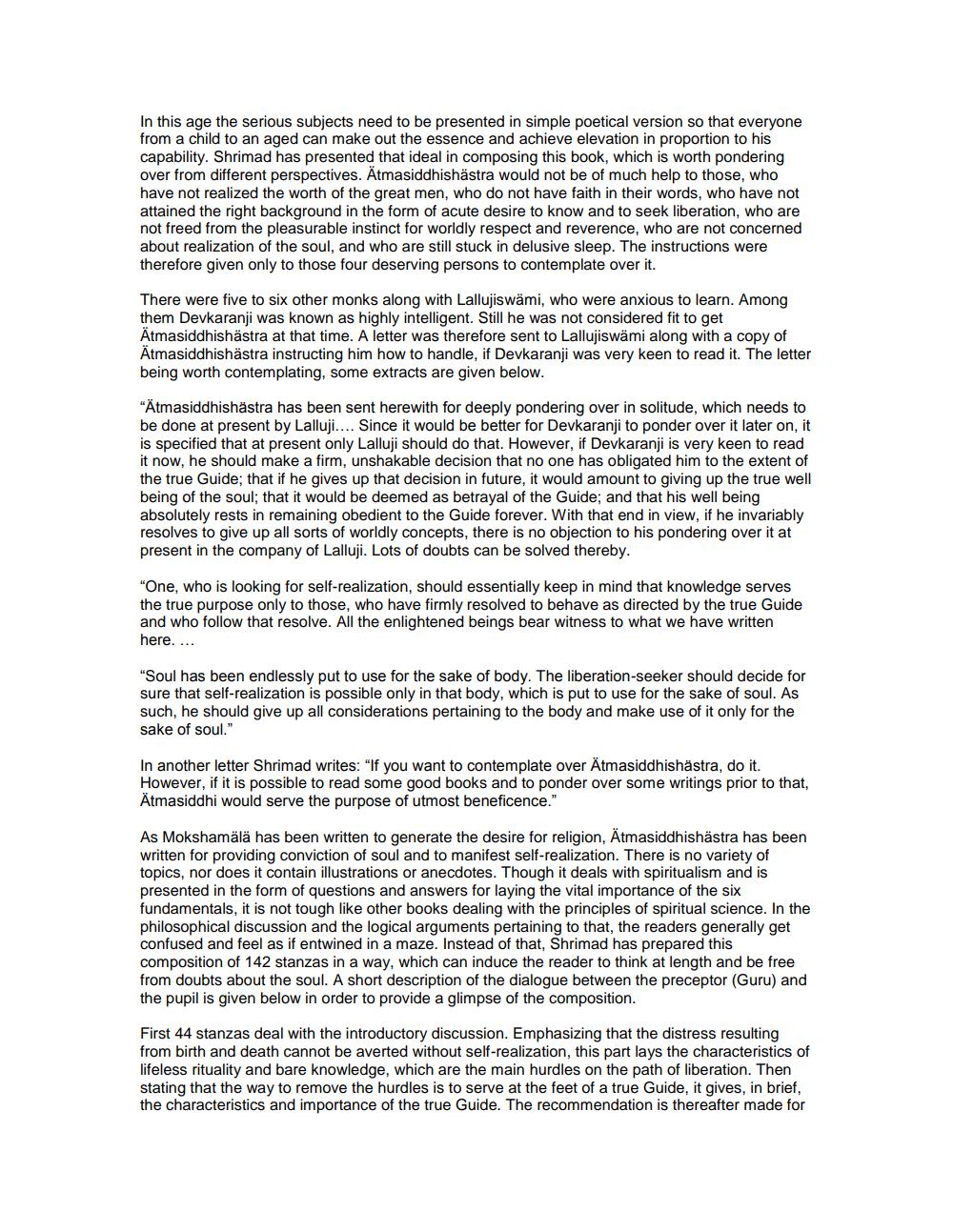________________
In this age the serious subjects need to be presented in simple poetical version so that everyone from a child to an aged can make out the essence and achieve elevation in proportion to his capability. Shrimad has presented that ideal in composing this book, which is worth pondering over from different perspectives. Atmasiddhishästra would not be of much help to those, who have not realized the worth of the great men, who do not have faith in their words, who have not attained the right background in the form of acute desire to know and to seek liberation, who are not freed from the pleasurable instinct for worldly respect and reverence, who are not concerned about realization of the soul, and who are still stuck in delusive sleep. The instructions were therefore given only to those four deserving persons to contemplate over it.
There were five to six other monks along with Lallujiswämi, who were anxious to learn. Among them Devkaranji was known as highly intelligent. Still he was not considered fit to get Ätmasiddhishästra at that time. A letter was therefore sent to Lallujiswämi along with a copy of Ätmasiddhishästra instructing him how to handle, if Devkaranji was very keen to read it. The letter being worth contemplating, some extracts are given below.
“Ätmasiddhishästra has been sent herewith for deeply pondering over in solitude, which needs to be done at present by Lalluji.... Since it would be better for Devkaranji to ponder over it later on, it is specified that at present only Lalluji should do that. However, if Devkaranji is very keen to read it now, he should make a firm, unshakable decision that no one has obligated him to the extent of the true Guide; that if he gives up that decision in future, it would amount to giving up the true well being of the soul; that it would be deemed as betrayal of the Guide, and that his well being absolutely rests in remaining obedient to the Guide forever. With that end in view, if he invariably resolves to give up all sorts of worldly concepts, there is no objection to his pondering over it at present in the company of Lalluji. Lots of doubts can be solved thereby.
"One, who is looking for self-realization, should essentially keep in mind that knowledge serves the true purpose only to those, who have firmly resolved to behave as directed by the true Guide and who follow that resolve. All the enlightened beings bear witness to what we have written here....
"Soul has been endlessly put to use for the sake of body. The liberation-seeker should decide for sure that self-realization is possible only in that body, which is put to use for the sake of soul. As such, he should give up all considerations pertaining to the body and make use of it only for the sake of soul."
In another letter Shrimad writes: "If you want to contemplate over Ätmasiddhishastra, do it. However, if it is possible to read some good books and to ponder over some writings prior to that, Atmasiddhi would serve the purpose of utmost beneficence."
As Mokshamälä has been written to generate the desire for religion, Ätmasiddhishästra has been written for providing conviction of soul and to manifest self-realization. There is no variety of topics, nor does it contain illustrations or anecdotes. Though it deals with spiritualism and is presented in the form of questions and answers for laying the vital importance of the six fundamentals, it is not tough like other books dealing with the principles of spiritual science. In the philosophical discussion and the logical arguments pertaining to that, the readers generally get confused and feel as if entwined in a maze. Instead of that, Shrimad has prepared this composition of 142 stanzas in a way, which can induce the reader to think at length and be free from doubts about the soul. A short description of the dialogue between the preceptor (Guru) and the pupil is given below in order to provide a glimpse of the composition.
First 44 stanzas deal with the introductory discussion. Emphasizing that the distress resulting from birth and death cannot be averted without self-realization, this part lays the characteristics of lifeless rituality and bare knowledge, which are the main hurdles on the path of liberation. Then stating that the way to remove the hurdles is to serve at the feet of a true Guide, it gives, in brief, the characteristics and importance of the true Guide. The recommendation is thereafter made for




